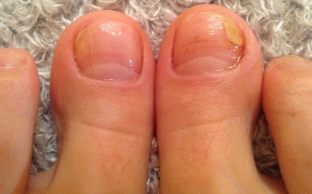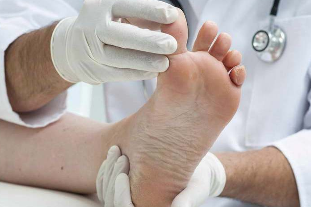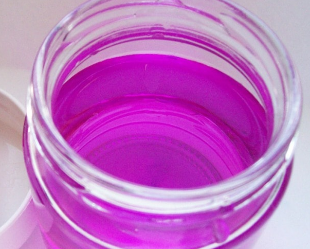Darkening of the plate of the nail, its thickening, consolidation, and deformation – all of this can be a sign of the development of nail fungus (onychomycosis). A lot of patients confuse the infection with bruises or psoriasis. To avoid the worsening of the disease, it is necessary to know how to determine the nail fungus of the feet, types, and symptoms.
Types of nail fungus

The more often a fungal infection doesn't only apply on the nail, but affects approximately-the area of the nail. Also suffers from the skin of the feet and the interdigital folds, like hands and feet (athlete's foot). Among the most encountered pathogens that cause negative changes can be distinguished:
- yeast mushrooms – hit the nail, making it thinner, which leads to flake off of the plate of the lodge;
- dermatophytes – by penetrating into the horny layer, causing the appearance of yellow spots or bands of white color, which increases with time;
- musty fungus penetrates into the upper layers of the plate, and the exchange rate, green, gray, or black.
When the infection affects the nails, in the early stages are already visible early changes from which we can distinguish 3 main types of mildew.
- Distal onychomycosis. Defeat starts from the edge of the horny layer, then the infection moves to the base of the plate. The nail is of a greyish colour, thickens or thins, collapse, and with time, almost entirely destroyed.
- Proximal of fungus. Stretches with the center of the plate, to cause a blackening and destruction.
- The surface onychomycosis. Accompanied by the emergence of white patches in the centre of the nail, or on the edges. At the beginning of the disease, the plate has no distortion, but the touch visible from its friability, which ultimately leads to a change of the lodge and the loss of the nail.
The first signs and symptoms of nail fungus
The development of the fungus is not a leak down. Already, a few days after the infection appear the first signs and symptoms that, over time, become more luminous.
- The nail is dull, loses the brightness, change the design of the plate, may appear yellow or white dots, the longitudinal lines.
- Change the shape of the nail, its deformation, which is accompanied by a thickening or thinning of the horny layer. This condition leads to flaking, the exhaustion of the plate, and then the separation of the lodge.
- You experience pain to pressure. The corneal layer and adjacent to the inflamed tissue.
- The appearance of diaper rash between the fingers and the unpleasant smell of the frapps nails.

The symptoms and signs help to recognize nail fungus in the early stages and distinguish it from other diseases, wounds, psoriasis, eczema, stripping).
The methods of diagnosis
The identification procedure is an onychomycosis or mycosis generally goes through several steps, which include specific techniques: clinical picture, microscopy.
Initially specialist draws attention to the symptoms and complaints of the patient, to the collection of clinical data. After an inspection of the nail plate and the skin around them, a doctor of the pre-detects the infection, to the exclusion of similar disease (psoriasis, red ringworm, problems with the normal power supply of the nail).
Accuracy of the confirmation of the disease specialist is the collection of material, to move the microscopic examination. Of the affected area is taken scraping tissue and in laboratory conditions is treated with a special substance.
More precisely diagnosing a variety of fungus contributes to the study of the biological material. The analysis is carried out after the microscopy. Makes sowing of scratching. The sample of the diseased tissue is placed in nutrient for the fungus environment. 3 to 5 days, you can get the results of the procedure. View of the fungus can not learn by building colonies, their original growth and color.
Thanks to the research infallibly defined the type of the virus and its susceptibility to some antimicrobial. This not only allows the identification of the exact causative agent of the infection, but to find an effective treatment.
How to determine the nail fungus at home?
Darkening of the nail plate, its brittleness and the exhaustion may not always witness of onychomycosis. To find out whether a fungal infection, you can use the iodine and potassium permanganate.
Define onychomycosis using potassium permanganate
The procedure for identification of the fungus takes a little time and easy to apply. In a tub with lukewarm water need to dissolve a little of the manganese to obtain a diluted solution. Place it in the liquid of the hand or foot, wait 5 to 10 minutes. During this time, nails turns into brown, the affected areas remain unchanged.
Identification of nail fungus using iodine
On the other hand, the manganese, the iodine may not indicate the presence of pathogens onychomycosis. The tool allows you to eliminate fungi, especially tinea versicolor. If the skin around the nail appeared peeling, redness, of such of the area to be treated with iodine. A healthy skin is almost not to darken under the alcoholic solution, and here the dead cut off the space will be saturated dark color.
How to differentiate nail fungus from other diseases?
In the early stages of development of the fungal infection can be confused with skin diseases (psoriasis, lichen), or nail damage. In order not to run the negative manifestations, it is important to know the main differences between yeast infections.

- Darkening of the nail plate, the appearance of yellow spots and longitudinal stripes, which with time become more and more and penetrate more deeply into the nail.
- The fluidity of the evolution of the disease without exacerbations and in a lull, as it is the case of psoriasis. Fungus deforms gradually the nail plate up to the detachment of the lodge.
- The smells and the painful sensations also has a mushroom bruises or injury psoriatic, eczema, stripping.
- The reasons of the appearance of the fungus can be visited public places (swimming pool, sauna), wearing tight shoes (microtrauma and scratches), increased sweating of the feet, diaper rash, as well as contact with an infected person.
- The fungus initially appears on a certain finger, the more often the great, and then affects the rest of the phalanx and interdigital area.
Listed differences are used to identify the fungus in the early stages of its development. Above all, understand that self-diagnosis is not enough. For an effective treatment needs an examination by a specialist.
Thrush – unpleasant and insidious disease, which is able to disguise itself as another condition (psoriasis, eczema). It is important to keep close track of the nails and feet, and in symptoms the time to consult your doctor for timely treatment.






























